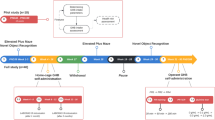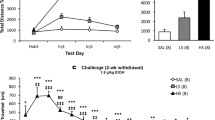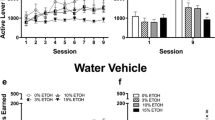Abstract
Rationale
Gamma-hydroxybutyrate (GHB) is a drug of abuse that is often coabused with ethanol (EtOH) and has been implicated as a date rape agent in conjunction with EtOH. Much information is lacking regarding the manner in which GHB interacts with EtOH.
Objective
This study was designed to further characterize the behavioral effects of GHB alone and in combination with EtOH in male Swiss–Webster mice.
Methods
The effects of GHB (0.1–1.0 g/kg) and EtOH (2.0–5.0 g/kg) alone, as well as the effects of GHB in combination with EtOH, were examined using an automated locomotor activity procedure, a functional observational battery (FOB) and a GHB drug discrimination procedure.
Results
GHB decreased, whereas EtOH had little effect on locomotor activity. In the FOB, EtOH dose-dependently decreased activity in combination with 0.3 g/kg GHB. Alone, each drug had little effect on the righting reflex, but combining ineffective doses of GHB and EtOH significantly impaired righting. GHB and EtOH decreased forelimb grip strength. Combinations of ineffective doses of GHB and EtOH decreased forelimb grip strength when given together. GHB and EtOH impaired inverted screen performance, and EtOH increased the impairing effects of low, but not high, doses of GHB. GHB and EtOH increased hind limb splay, and EtOH increased the effects of 0.1 and 0.3 g/kg GHB on splay. GHB and EtOH decreased body temperature, and EtOH augmented the temperature-decreasing effects of GHB. EtOH produced less than 50% GHB-like discriminative stimulus effects, and GHB failed to alter the GHB-like discriminative stimulus effects of EtOH.
Conclusions
Overall, EtOH increased the effects of GHB on several gross measures of behavior and only partially occasioned the discriminative stimulus properties of GHB.






Similar content being viewed by others
References
Allan AM, Harris RA (1989) A new alcohol antagonist: phaclofen. Life Sci 45:1771–1779
Baker LE, Pynnonen D, Poling A (2004) Influence of reinforcer type and route of administration on gamma-hydroxybutyrate discrimination in rats. Psychopharmacology (Berl) 174:220–227
Beleslin DB, Djokanovic N, Jovanovic Micic D, Samardzic R (1997) Opposite effects of GABAA and NMDA receptor antagonists on ethanol-induced behavioral sleep in rats. Alcohol 14:167–173
Bellis MA, Hughes K, Bennett A, Thomson R (2003) The role of an international nightlife resort in the proliferation of recreational drugs. Addiction 98:1713–1721
Bowen SE, Wiley JL, Evans EB, Tokarz ME, Balster RL (1996) Functional observational battery comparing effects of ethanol, 1,1,1-trichloroethane, ether, and flurothyl. Neurotoxicol Teratol 18:577–585
Carai MA, Colombo G, Brunetti G, Melis S, Serra S, Vacca G, Mastinu S, Pistuddi AM, Solinas C, Cignarella G, Minardi G, Gessa GL (2001) Role of GABA(B) receptors in the sedative/hypnotic effect of gamma-hydroxybutyric acid. Eur J Pharmacol 428:315–321
Carter LP, Flores LR, Wu H, Chen W, Unzeitig AW, Coop A, France CP (2003) The role of GABAB receptors in the discriminative stimulus effects of gamma-hydroxybutyrate in rats: time course and antagonism studies. J Pharmacol Exp Ther 305:668–674
Cash CD (1994) Gammahydroxybutyrate: an overview of the pros and cons for it being a neurotransmitter and/or a useful therapeutic agent. Neurosci Biobehav Rev 18:291–304
Chester JA, Cunningham CL (1999) Baclofen alters ethanol-stimulated activity but not conditioned place preference or taste aversion in mice. Pharmacol Biochem Behav 63:325–331
Colombo G, Agabio R, Bourguignon J, Fadda F, Lobina C, Maitre M, Reali R, Schmitt M, Gessa GL (1995a) Blockade of the discriminative stimulus effects of γ-hydroxybutyric acid (GHB) by the GHB receptor antagonist NCS-382. Physiol Behav 58:587–590
Colombo G, Agabio R, Lobina C, Reali R, Fadda F, Gessa GL (1995b) Symmetrical generalization between the discriminative stimulus effects of gamma-hydroxybutyric acid and ethanol: occurrence within narrow dose ranges. Physiol Behav 57:105–111
Colombo G, Agabio R, Lobina C, Reali R, Gessa GL (1998) Involvement of GABA(A) and GABA(B) receptors in the mediation of discriminative stimulus effects of gamma-hydroxybutyric acid. Physiol Behav 64:293–302
Cook CD, Aceto MD, Coop A, Beardsley PM (2002) The effects of the putative antagonist NCS382 on the behavioral pharmacological actions of gammahydroxybutyrate in mice. Psychopharmacology (Berl) 160:99–106
Craig K, Gomez HF, McManus JL, Bania TC (2000) Severe gamma-hydroxybutyrate withdrawal: a case report and literature review. J Emerg Med 18:65–70
Deimling MJ, Schnell RC (1980) Circadian rhythms in the biological response and disposition of ethanol in the mouse. J Pharmacol Exp Ther 213:1–8
Drug Abuse Warning Network (2002) The DAWN Report: club drugs, 2001 update. US Department of Health and Human Services, Washington, DC, pp 1–4
Faingold CL, N’Gouemo P, Riaz A (1998) Ethanol and neurotransmitter interactions—from molecular to integrative effects. Prog Neurobiol 55:509–535
Federal Register (2000) Placement of gamma-butyrolactone in list I of the controlled substances act (21 U.S.C. 802(34)). Drug enforcement administration, justice. Final rule. Fed Regist 65:21645–21647
Finn DA, Syapin PJ, Bejanian M, Jones BL, Alkana RL (1994) Temperature dependence of ethanol depression in mice: dose response. Alcohol Clin Exp Res 18:382–386
Friedman J, Westlake R, Furman M (1996) “Grievous bodily harm:” gamma hydroxybutyrate abuse leading to a Wernicke–Korsakoff syndrome. Neurology 46:469–471
Frye GD, Breese GR (1981) An evaluation of the locomotor stimulating action of ethanol in rats and mice. Psychopharmacology (Berl) 75:372–379
Frye GD, Breese GR (1982) GABAergic modulation of ethanol-induced motor impairment. J Pharmacol Exp Ther 223:752–756
Gallimberti L, Vanton G, Gentile N, Ferri M, Cibin M, Ferrara SD, Fadda F, Gessa GL (1989) Gamma-hydroxybutyric acid for treatment of alcohol withdrawal syndrome. Lancet 2:787–789
Gallimberti L, Ferri M, Ferrara SD, Fadda F, Gessa GL (1992) Gamma-hydroxybutyric acid in the treatment of alcohol dependence: a double-blind study. Alcohol Clin Exp Res 16:673–676
Galloway GP, Frederick SL, Staggers FE, Gonzales M, Stalcup SA, Smith DE (1997) Gamma-hydroxybutyrate: an emerging drug of abuse that causes physical dependence. Addiction 92:89–96
Gordon CJ, Stead AG (1988) Effect of ethyl alcohol on thermoregulation in mice following the induction of hypothermia or hyperthermia. Pharmacol Biochem Behav 29:693–698
Humeniuk RE, White JM, Ong J (1993) The role of GABAB receptors in mediating the stimulatory effects of ethanol in mice. Psychopharmacology (Berl) 111:219–224
Kalant H, Le AD (1983) Effects of ethanol on thermoregulation. Pharmacol Ther 23:313–364
Kaufman EE, Porrino LJ, Nelson T (1990) Pyretic action of low doses of gamma-hydroxybutyrate in rats. Biochem Pharmacol 40:2637–2640
Koek W, Flores LR, Carter LP, Lamb RJ, Chen W, Wu H, Coop A, France CP (2004) Discriminative stimulus effects of gamma-hydroxybutyrate in pigeons: role of diazepam-sensitive and -insensitive GABA(A) and GABA(B) receptors. J Pharmacol Exp Ther 308:904–911
Laborit H, Jouany JM, Gerard J, Fabiani F (1960) Experimental study and clinical application of sodium hydroxybutyrate. Rev Agressol 1:397–406
Liljequist S, Engel J (1982) Effects of GABAergic agonists and antagonists on various ethanol-induced behavioral changes. Psychopharmacology (Berl) 78:71–75
Lin MT, Chern YF, Wang HS, Chandra A (1979) Effects of gamma-hydroxybutyric acid on metabolic, respiratory and vasomotor activities and body temperature in rats. J Pharmacol Exp Ther 211:167–170
Lingenhoehl K, Brom R, Heid J, Beck P, Froestl W, Kaupmann K, Bettler B, Mosbacher J (1999) Gamma-hydroxybutyrate is a weak agonist at recombinant GABA(B) receptors. Neuropharmacology 38:1667–1673
Lobina C, Agabio R, Reali R, Gessa GL, Colombo G (1999) Contribution of GABAA and GABAB receptors to the discriminative stimulus produced by gamma-hydroxybutyric acid. Pharmacol Biochem Behav 64:363–365
Maitre M (1997) The gamma-hydroxybutyrate signalling system in brain: organization and functional implications. Prog Neurobiol 51:337–361
Maitre M, Hechler V, Vayer P, Gobaille S, Cash CD, Schmitt M, Bourguignon J (1990) A specific gamma-hydroxybutyrate receptor ligand possesses both antagonistic and anticonvulsant properties. J Pharmacol Exp Ther 255:657–663
Malcolm RD, Alkana RL (1981) Temperature dependence of ethanol depression in mice. J Pharmacol Exp Ther 217:770–775
Martellotta MC, Cossu G, Fattore L, Gessa GL, Fratta W (1998) Intravenous self-administration of gamma-hydroxybutyric acid in drug-naive mice. Eur Neuropsychopharmacol 8:293–296
Mathivet P, Bernasconi R, De Barry J, Marescaux C, Bittiger H (1997) Binding characteristics of γ-hydroxybutyric acid as a weak but selective GABAB receptor agonist. Eur J Pharmacol 321:67–75
McCabe ER, Layne EC, Sayler DF, Slusher N, Bessman SP (1971) Synergy of ethanol and a natural soporific-gamma hydroxybutyrate. Science 171:404–406
Mehta AK, Muschaweck NM, Maeda DY, Coop A, Ticku MK (2001) Binding characteristics of the gamma-hydroxybutyric acid receptor antagonist [(3)H](2E)-(5-hydroxy-5,7,8,9-tetrahydro-6H-benzo[a][7]annulen-6-ylidene) ethanoic acid in the rat brain. J Pharmacol Exp Ther 299:1148–1153
Metcalf BR, Stahl JM, Allen JD, Woolfolk DR, Soto PL (2001) Discrimination of gamma-hydroxybutyrate and ethanol administered separately and as a mixture in rats. Pharmacol Biochem Behav 70:31–41
Miotto K, Darakjian J, Basch J, Murray S, Zogg J, Rawson R (2001) Gamma-hydroxybutyric acid: patterns of use, effects and withdrawal. Am J Addict 10:232–241
Moser VC, McCormick JP, Creason JP, MacPhail RC (1988) Comparison of chlordimeform and carbaryl using a functional observational battery. Fundam Appl Toxicol 11:189–206
National Research Council (1996) Guide for the care and use of laboratory animals. National Academy Press, Washington, DC
Okamoto M, Rao SN, Aaronson LM, Walewski JL (1985) Ethanol drug interaction with chlordiazepoxide and pentobarbital. Alcohol Clin Exp Res 9:516–521
Orphan Medical (2002) Orphan Medical receives FDA approvable letter for Xyrem. http://www.orphan.com/articledetail.cfm?aid=4&id=342
Ratomponirinia C, Hode Y, Hechler V, Maitre M (1995) Gammahydroxybutyrate receptor binding in rat brain is inhibited by guanyl nucleotides and pertussis toxin. Neurosci Lett 189:51–53
Schwartz RH, Milteer R, LeBeau MA (2000) Drug-facilitated sexual assault (“date rape”). South Med J 93:558–561
Slaughter L (2000) Involvement of drugs in sexual assault. J Reprod Med 45:425–430
Snead OC III (1978) Gamma hydroxybutyrate in the monkey. I. Electroencephalographic, behavioral, and pharmacokinetic studies. Neurology 28:636–642
Substance Abuse and Mental Health Services Administration (2002) Detailed emergency department tables from the drug abuse warning network: 2002. US Department of Health and Human Services, Washington, DC
Tegeris JS, Balster RL (1994) A comparison of the acute behavioral effects of alkylbenzenes using a functional observational battery un mice. Fundam Appl Toxicol 22:240–250
Van Sassenbroeck DK, De Paepe P, Belpaire FM, Buylaert WA (2003) Characterization of the pharmacokinetic and pharmacodynamic interaction between gamma-hydroxybutyrate and ethanol in the rat. Toxicol Sci 73:270–278
Winter JC (1981) The stimulus properties of gamma-hydroxybutyrate. Psychopharmacology (Berl) 73:372–375
Acknowledgement
C.D.C. was supported by a National Institute on Drug Abuse Training Grant (DA07027) during the execution of these studies.
Author information
Authors and Affiliations
Corresponding author
Rights and permissions
About this article
Cite this article
Cook, C.D., Biddlestone, L., Coop, A. et al. Effects of combining ethanol (EtOH) with gamma-hydroxybutyrate (GHB) on the discriminative stimulus, locomotor, and motor-impairing functions of GHB in mice. Psychopharmacology 185, 112–122 (2006). https://doi.org/10.1007/s00213-005-0276-0
Received:
Accepted:
Published:
Issue Date:
DOI: https://doi.org/10.1007/s00213-005-0276-0




